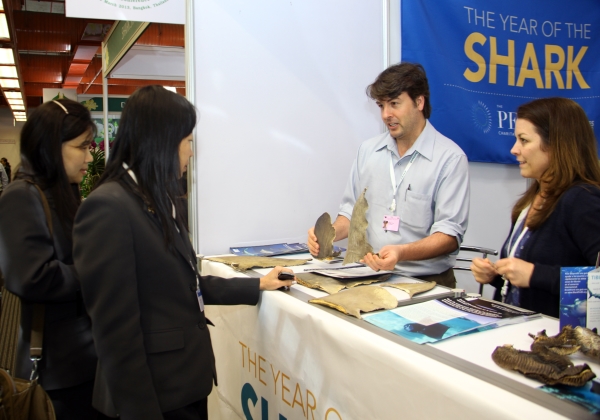Sunday, September 14th may seem like just another Sunday to some people but not to those in the shark world. Not only are sharks breathing a huge sigh of relief but so are many people in countries around the world. September 14th is the first day a landmark shark protection act went into effect. Under the Convention on International Trade of Endangered Species (CITES), this new restriction states that international trade in five species of shark and two species of manta ray must be proven to be legal and sustainable, if it is to continue. Putting this requirement in place will hopefully change global shark trade and in turn provide these threatened species with a chance for recovery and survival.
Many shark populations have been overfished to supply the dried shark fin trade in Asia, where the fins are made into the Cantonese delicacy shark fin soup. Shark fins can run as high as $1,000 per kilogram in China and Hong Kong, so it is no surprise that fishermen all over the world pounced on sharks as the Chinese economy grew and demand for this luxury item increased. It was recently estimated that humans kill around 100 million sharks each year. With their slow growth and low reproductive rates, sharks simply cannot replenish their populations as quickly as they are being depleted
Assistant Professor, Demian Chapman has been instrumental in making the CITES listings happen and is now on the frontlines of making them work. For more than three years, he has been part of a global effort to include porbeagle, oceanic whitetip sharks, three species of hammerhead sharks – scalloped, great, and smooth – as well as all species of manta ray to CITES Appendix II. Appendix II states that species can be traded, but only if the trade is legal and does not cause detriment to the species in the wild. CITES was established in 1975 through an international treaty for the sole purpose of protecting wild animals and plants from overexploitation in international trade. Once a government becomes a CITES party, it is bound to implement the Convention. CITES currently has 180 parties.
Dr. Chapman’s efforts are in concert with his wife and researcher partner, Debra Abercrombie, and involve training border control personnel to recognize the fins of CITES listed sharks on sight so they can enforce these trade restrictions. His student Andrew Fields is also working in Hong Kong to shed more light on the trade of CITES species. These research and outreach activities are essential components of a global effort to bring sharks back from the brink. While there is a great deal of work to be done, there are encouraging signs that we will succeed – our ocean ecosystems depend on it.
More information can be found on the Pew Charitable Trusts website.






You must be logged in to post a comment.